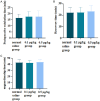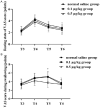Intravenous injection of 0.5 μg/kg dexmedetomidine during plasma resection of tonsil adenoids can reduce the incidence of delirium and hemodynamics in children
- PMID: 40226004
- PMCID: PMC11982874
- DOI: 10.62347/TWCY6801
Intravenous injection of 0.5 μg/kg dexmedetomidine during plasma resection of tonsil adenoids can reduce the incidence of delirium and hemodynamics in children
Abstract
Objective: To investigate the effects of different doses of dexmedetomidine on delirium and hemodynamics after plasma resection of adenoids in children.
Methods: A retrospective analysis was conducted on the clinical data of 80 children who underwent plasma adenoidectomy of tonsil at the Pediatric Hospital of Fudan University from January 2022 to December 2023. The patients were divided into normal saline group, 0.1 μg/kg dexmedetomidine group, and 0.5 μg/kg dexmedetomidine group according to the dose of dexmedetomidine injected intravenously. Hemodynamic changes, modified Yale Preoperative Anxiety Scale (mYPAS-SF) scores, pharyngeal pain (at rest and during swallowing), coagulation function, and postoperative adverse reactions were compared at T0, 10 min after dexmedetomidine pumping (T1), extubation (T2), recovery (T3), 2 h after returning to ward (T4), 12 h after returning to ward (T5) and 24 h after returning to ward (T6), respectively.
Results: There were no significant differences in extubation time, recovery time, or unguardianship time among the three groups (P>0.05). The incidence of postoperative delirium was significantly lower in the 0.1 μg/kg dexmedetomidine group and 0.5 μg/kg dexmedetomidine group compared to the normal saline group (P<0.05), with the 0.5 μg/kg group showing better results. At T2, heart rate (HR) and mean arterial pressure (MAP) levels were significantly lower in 0.1 μg/kg group and 0.5 μg/kg dexmedetomidine group than those in normal saline group (P<0.05). The mYPAS-SF score was significantly lower in the 0.1 μg/kg group and 0.5 μg/kg dexmedetomidine groups than that of the normal saline group at T3, T4 and T5 (P<0.05). The score of pharyngeal pain during swallowing was significantly lower in the 0.5 μg/kg dexmedetomidine group at T5 than that of the normal saline group and 0.1 μg/kg dexmedetomidine group (P<0.05). Coagulation values (PT, APTT, and TT) were significantly altered 36 hours post-surgery, with PT, APTT, and TT increasing, while fibrinogen (FIB) decreased (P<0.05). Postoperative nasopharyngeal hemorrhage occurred in one case and nausea/vomiting in two cases in the saline group. No anesthesia-related adverse reactions were observed in the dexmedetomidine group.
Conclusion: Intravenous injection of 0.5 μg/kg dexmedetomidine during plasma resection of tonsillar adenoids can reduce the incidence of postoperative delirium, stabilize hemodynamics, relieve postoperative anxiety and pharyngeal pain, with minimal impacts on coagulation function. Additionally, it reduces the incidence of adverse reactions, making it a promising option for clinical use.
Keywords: Dexmedetomidine; plasma resection of tonsil adenoid; postoperative delirium.
AJTR Copyright © 2025.
Conflict of interest statement
None.
Figures





Similar articles
-
Analysis of anesthetic effect of dexmedetomidine in femoral shaft fracture surgery.Medicine (Baltimore). 2022 Dec 30;101(52):e32388. doi: 10.1097/MD.0000000000032388. Medicine (Baltimore). 2022. PMID: 36596048 Free PMC article. Clinical Trial.
-
Effect of dexmedetomidine on intracranial pressure in patients undergoing gynecological laparoscopic surgery in Trendelenburg position through ultrasonographic measurement of optic nerve sheath diameter.Am J Transl Res. 2022 Sep 15;14(9):6349-6358. eCollection 2022. Am J Transl Res. 2022. PMID: 36247291 Free PMC article.
-
Application of Different Doses of Dexmedetomidine Combined with General Anesthesia in Anesthesia of Patients with Traumatic Tibiofibular Fractures and Its Effect on the Incidence of Adverse Reactions.J Healthc Eng. 2021 Dec 14;2021:3080098. doi: 10.1155/2021/3080098. eCollection 2021. J Healthc Eng. 2021. PMID: 34950440 Free PMC article.
-
Evaluation of dexmedetomidine in combination with sufentanil or butorphanol for postoperative analgesia in patients undergoing laparoscopic resection of gastrointestinal tumors: A quasi-experimental trial.Medicine (Baltimore). 2016 Dec;95(50):e5604. doi: 10.1097/MD.0000000000005604. Medicine (Baltimore). 2016. PMID: 27977600 Free PMC article. Clinical Trial.
-
Effect of dexmedetomidine anesthesia on respiratory function in pediatric patients undergoing retinoblastoma resection.Oncol Lett. 2019 Mar;17(3):2721-2728. doi: 10.3892/ol.2019.9893. Epub 2019 Jan 4. Oncol Lett. 2019. PMID: 30867730 Free PMC article.
References
-
- Hao X, Wang JZ, Qu H. Effect of resection of adenoids and/or tonsil on the immune indexes in children with obstructive sleep apnea hypopnea syndrome. Zhonghua Er Bi Yan Hou Tou Jing Wai Ke Za Zhi. 2019;54:830–836. - PubMed
-
- Abdallah BM, Elshoeibi AM, ElTantawi N, Arif M, Hourani RF, Akomolafe AF, Hamwi MN, Mahmood FR, Saracoglu KT, Saracoglu A, Chivese T. Comparison of postoperative pain in children after maintenance anaesthesia with propofol or sevoflurane: a systematic review and meta-analysis. Br J Anaesth. 2024;133:93–102. - PMC - PubMed
-
- Urbánek L, Urbánková P, Satinský I, Trávníček T, Penka I, Hruda J. Postoperative delirium. Rozhl Chir. 2023;102:381–386. - PubMed
LinkOut - more resources
Full Text Sources
